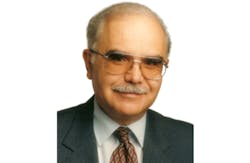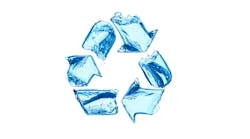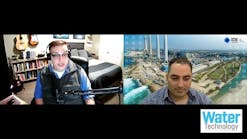It is always interesting to find out the career path for anyone as their journey always seems to end up taking you somewhere you didn’t expect. The same can be said for the path Dr. Joseph Cotruvo took and is currently traveling. After attaining a BS in chemistry from the University of Toledo and a Ph.D. in physical organic chemistry from Ohio State University, Cotruvo was on his way to being a research chemist, developing new chemical structures and products.
But, after spending some time in the laboratory, he decided he would rather work in a more public environment. “I was interested in science, law and policy interaction so I moved to Washington and began studying law and started with the Environmental Protection Agency (EPA) in 1973.”
The EPA was just getting started and involved all the factors Cotruvo was looking for to further his career. He began as a senior policy reviewer of pesticides and wastewater regulation development before moving into senior management positions.
In 1974, the Safe Drinking Water Act (SDWA) passed and Cotruvo was asked to help get things started in the new drinking water office. “That was my first involvement in drinking water,” he says. “It turned out to be an ideal position. We built it from ground zero and staffed it with the best people that were available. Implementing a law with a lot of essential technical underpinning was the perfect opportunity for me to integrate science, law and public policy and it was pure good fortune that I was in the right place at the right time.”
After 25 years with the EPA in Washington as director of the Drinking Water Standards Division in the Water Office and as director of the Risk Assessment Division in the Toxics and Pollution Prevention office, he retired from EPA and became the vice president for Environmental Health Sciences at NSF International.
In 2000, he decided it was the right time to start his own company, Joseph Cotruvo & Associates LLC. This group of experts looks to solve problems involving water, the environment and public health.
Applied science
Cotruvo was able to use his background in science to help make informed decisions within the water industry to protect drinking water and public health.
“That was somewhat unusual at the time because agency managers tended to be lawyers, MBAs and generalists,” Cotruvo explains. “So I could understand the scientific underpinnings of the environmental and inorganic and organic and analytical chemistry, water treatment technology and toxicology that were key to producing scientifically and technically based regulations. That was a big advantage. The law and public policy elements were learned by on-the-job experience dealing with the lawyers, states, water industry and politicians.”
This scientific experience especially came in handy when the EPA was dealing with contamination issues surrounding trihalomethane (THM) byproducts of chlorine disinfection. This threw quite a wrench into the water industry as chlorine was the main component of drinking water treatment during this time.
The newly developed staff had to work quickly in order to find a solution. “Working closely with the still incompletely formed division staff and research staff, we developed the national occurrence information, monitoring methodology, treatment technology and economic impact information. Then, we formulated a regulatory strategy by extrapolating the law’s authorities and that used THMs as indicators of the hundreds of unknown chlorination byproducts, while protecting the essential use of chlorine to maintain the microbial quality of water.”
Cotruvo adds that THMs led to the stronger need of science and engineering-based thinking that now exists in the water industry.
Starting Joseph Cotruvo & Associates LLC
After working in the government and industry part of the business for 25-plus years, Cotruvo decided it was time for a change. He wanted to get away from the corporate structure and focus on topics that he really enjoyed, while making good use of his experience by helping companies and water people solve problems.
After retiring from EPA and working for NSF, he decided to start Joseph Cotruvo & Associates LLC in 2000. “The experience of technical training and the mix of science, regulatory and public institution work was ideal. I have been at it for 13 years and work from Singapore to Europe to the Middle East and have expanded into wastewater reuse and desalination issues. I also serve on the BOD of Washington D.C. Water. It has been a great ride and I never could have predicted the outcome.”
Cotruvo shares a great deal of concern for people seeking clean water and with his knowledge and experience he hopes to be able to help those with water issues around the globe.
“I like the challenge and the opportunity to help clients solve real and complex problems. By integrating technology, health risk, science and regulatory strategy, I bring a multidisciplinary approach that helps cut through to the real choices and their health and practical consequences,” notes Cotruvo. “The opportunity to work internationally with a great variety of people and cultures is personally very rewarding. One gets the sense that the world is a very large place but the people and the issues that they face are very similar everywhere. But, I do not appreciate the 12 to 16 hour airplane rides.”
Dealing with contamination
One of Cotruvo’s many strengths over his career has been his knowledge for water contamination. He has played a huge role in helping describe the many different contaminants in Water Technology’s Contaminant of the Month section, and he also shares this knowledge in several other ways. He has been involved with the World Health Organization (WHO) for many years as an expert adviser for developing its “Guidelines for Drinking Water Quality.” Cotruvo also led a study on the basic toxicological mechanisms of bromate and understanding its real risk in drinking water.
“I also like writing regularly for Water Technology because it is an opportunity to communicate about many issues that are relevant to the water industry,” adds Cotruvo.
He has written articles for this publication in particular to help spread the awareness of water contamination as well as limiting concerns for other contaminants that have found to not be as harmful.
“I also have consulted for several countries and major companies, including some in POU/POE, that have water and health related issues and serve on numerous panels that advise water authorities on major water reuse projects,” he says.
After a quarter of a century in the industry Cotruvo feels now is the time for him to educate others on what he’s learned throughout his career, hoping to ease the minds of those on water contamination and educating them on ways to be safe.
Looking to the future
Like many, Cotruvo believes the municipal water industry especially is on the rise as it’s matured and expanded over the last 40 years. “It (municipal water industry) has become much better educated in the science and technology of water provision and much more sensitive to public concerns,” educates Cotruvo. “Technologies like ozonation, membranes and granular carbon that were unheard of then in American water have now become routine. Analytical methods like GC/MS, inductively couple plasma emission spectroscopy are widely used.”
Cotruvo adds that some public concerns are misplaced, saying that the majority of drinking water in the U.S. is safe and getting even safer.
The main question Cotruvo foresees for the future of the industry is: What will be the paradigm for the provision of public drinking water and the water industry for the future?
He notes that less than 1 percent of water supplies is actually used for drinking and cooking, posing the question, “Does it really make sense to be producing millions of gallons per day at higher and higher quality, then shipping it through many miles of pipe to a consumer for drinking?”
Cotruvo proposes the possibility of there being a distinction between beverage water and commodity water.
“Remote real-time sensing of important quality parameters will be key to typical water supply operations and particularly for the greater introduction of potable water reuse applications,” says Cotruvo. “Water availability is already the most important threat in many parts of the world so water reuse will become more and more prevalent.”
Cotruvo is married to Karen Cotruvo and they have one son Joey, who is following in his father’s footsteps with a Ph.D. from MIT in Bioinorganic Chemistry. But, as the elder Cotruvo can probably attest, you never know where your career will take you. Some 40 years ago helping raise water contamination awareness to people around the globe probably wasn’t on his to-do list, but this industry is much better off because of the path he chose.


